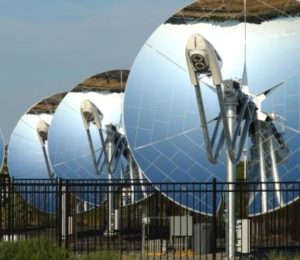
Flinders University’s expertise in nanotechnology will be employed as part of an $87 million project aimed at transforming Australia into a global solar energy powerhouse.
The Australian Solar Thermal Research Initiative (ASTRI), led by CSIRO, is a major partnership between six leading Australian research institutions, the US Department of Energy’s National Renewable Energy Laboratory, the Sandia National Laboratories and Arizona State University.
The ASTRI consortium will work collaboratively over the next eight years to create technologies that will supply cost-effective, energy efficient, secure electricity to Australia and the world, with a key focus on cutting the cost of concentrated solar power from 25 cents to 9-12 cents a kilowatt hour.
Concentrated solar power, also known as solar thermal energy, uses mirrors to concentrate energy from the sun to generate heat. The heat can be used to power turbines to create electricity or used with appropriate chemical reactions to produce solar-derived fuel.
Flinders University Centre for NanoScale Science and Technology Director, Professor David Lewis said 15-20 Flinders researchers would work on the solar thermal initiative during the next eight years, with a primary focus on developing new materials to reduce the overall cost of building and maintaining concentrated solar cells.
“In one form of concentrated solar thermal power generation, large-scale mirrors are used to concentrate the sun’s energy to heat fluid inside a pipe which subsequently transfers that heat into an electrical power generator to create electricity,” Professor Lewis said.
“To get the most out of solar energy the facility is typically built in cloud-free regions but then maintenance costs become an issue due to having to clean dust from the surface of the mirrors, so we’ll be working on new coatings to prevent the dust build-up in the first place,” he said.
“We’ll also be focusing on making low-cost, lightweight mirrors, fluids and anti-corrosion coatings that can withstand higher temperatures to improve the efficiency of the system and further reduce maintenance costs.”
Professor Lewis said the aim of the project was to equip Australia with the skills and capabilities to become a global leader in concentrated solar power technology.
“What the consortium aims to do is build the capabilities in Australia so that we can manufacture and build power plants here and create export markets, ultimately leading to more jobs in Australia.”
The initiative, announced on December 13 by Federal Resources and Energy Minister Martin Ferguson, has been funded through a $35 million grant from the Australian Solar Institute and the Australian Renewable Energy Agency.


I love this intensive effort to find out alternative energy sources. Hopefully, we will get a significant improvement on it and we will be a global leader in solar power technology.
This is great to see, we need to forget Coal and Coal Seam Gas and find REAL solutions to our energy needs- like this 🙂
This research is sorely needed. Research dollars almost always pay for themselves
with new discoveries. I will keep my eye out for this Australian Solar Thermal Research
Initiative in the future, and actively pursue work involved with installing these new developments.
This is what I have wanted to see for 20 years, but the oil companies had a hold on allowing research to surface or become commercially available. Great to see, CSIRO and the other Research organisations, keep it up!